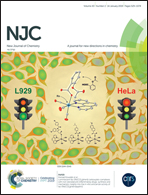3-Selenocyanate-indoles as new agents for the treatment of superficial and mucocutaneous infections†
Abstract
The development of resistance to the current antifungal agents is an alarming problem. Therefore, the search for new molecules capable of combating fungi infections is imperative. This study presents the in vitro activities of a library of seven 3-selenocyanate-indoles against Candida spp. and dermatophytes of the genera Trichophyton and Microsporum. The antifungal susceptibility of compounds 4a and 4b presented geometric mean values of 4.1 and 6.0 μg mL−1 against Candida spp. and 1.2 and 2.2 μg mL−1 against dermatophytes following the CLSI guidelines. The 3-selenocyanate-indole 4a showed a fungicidal effect against the whole fungal panel. The toxicological results revealed that the selenocyanates 4a and 4b did not show mutagenicity or cause changes in the human leukocyte cells and were classified as non-irritant by the ex vivo HET-CAM test. The mechanism of action of the 3-selenocyanate-indoles has not been clearly elucidated. However, a genotoxic potential in higher concentrations, observed by the comet assay, leads us to believe that these molecules have their mechanism of action related to the nucleus of the fungal cells.



 Please wait while we load your content...
Please wait while we load your content...